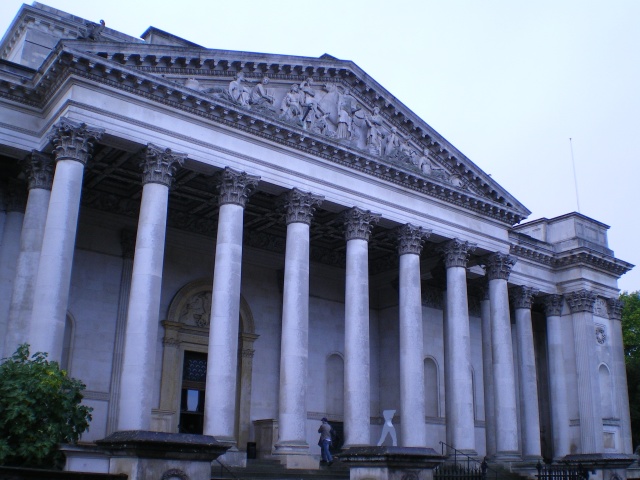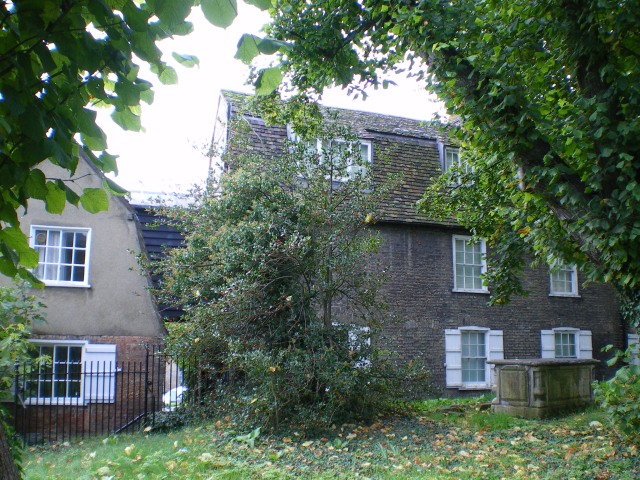Cambridge is a fantastic place to spend a few years. Its yellow stone and gothic architecture is a feast for the eyes, particularly when moodily reflected in dark puddles on rainy nights, or when basking provocatively in glaring summer sun. Most of the students and academics are alive with interest and enthusiasm and are fantastic companions. With all the activity of undergraduate life, it is, however, all to easy to pass by Cambridge’s museums and galleries. So, during my last few weeks there, I took the time to have another look around some of my favourites.
I approached my first target, the Fitzwilliam Museum, with a critical eye. With different museums operating under very different financial circumstances, and with very different collections, I thought it best to not judge them by the quality of their collection, but by their success as a museum. I wanted to evaluate how well they communicated to the visitor.

The Fitzwilliam Museum is housed in a grand building, and its main entrance opens into an opulent and lofty space. An excellent canvas for expensive, exquisite artworks, articulating the context in which they were produced and viewed. So far, so good. Wandering down the stairs to the right, however, things began to go wrong.
I came face-to-face with an Assyrian frieze. The accompanying text identified this particular Assyrian mythical figure, but ventured nothing besides the name and job description. This object would have been far more effective had it been accompanied by some information on the god. Perhaps a summary of a relevant myth, an explanation of how or why this god was worshipped or a comparison to similar gods from other religious cultures. Anything to mediate between the ancient, unknown object in front of me and my own lack of understanding. If we know nothing more about the figure, then that’s something to explore as well.
It’s unfair to expect objects to unproblematically explain themselves to their audience, or for the audience to be able to understand them without explanation. A museum has to ensure that it bridges the gap between the visitor and the object. If the visitor doesn’t leave having engaged with the object, the museum has failed. If we aren’t careful, a museum risks being a collection of trinkets, whose importance is only understood by those who look after them. And that’s a dangerous result at a time when the cultural sector is fighting for funding.
Having descended into the Egyptian section, I was much more impressed by what I saw. Each cabinet had a good overarching explanation, articulating why the objects had been displayed together, but the treatment of individual objects gave no real sense of their significance. I spotted an impressive model house, but no explanation of its purpose or significance was ventured.
During my visit to the Fitzwilliam, I’d seen some exciting objects, and they were well preserved and carefully displayed, but the museum could have done more to help the visitor engage with them. At its best, the Fitzwilliam does a fantastic job of this, unpicking the narratives of classical sarcophagi, for example, which makes it all the more frustrating when it does not do so.
Wandering through the museum’s art collection, I wondered how far you can apply these thoughts to pieces of art. How should we display art? Should it simply be labelled, or should there be an attempt at explaining what the work is trying to do? Do you try and explain the symbolic language that it’s employing? If we do these things, we risk patronising the visitor, and, worse still, attempt to exercise control over the meaning and importance of a work. We must always allow for free and extravagant personal interpretation and response. But there must be a case for painting broad brush strokes, and for giving the intelligent non-expert the tools needed to engage with the work. Because if that doesn’t happen here, where else will it?
Whether it’s an obscure stone carving or a work of art, it’s far better for the viewer to know nothing about the work, and to be allowed to think anything, than to be told everything about it and its meaning, and be allowed to think nothing. But I think we can improve upon silence.
A short walk from the Fitzwilliam Museum is the unassuming Whipple Museum of the History of Science. I wandered in, expecting to have another look at its various scientific instruments, but was hooked in by a little cabinet on the Gömböc. It tempted me in with the obvious question – what is it? – and went from there, explaining why this shape is special, and looking at examples of this mathematical peculiarity in nature. A brilliant narrative, ushering this strange object into my mental universe without patronising me. The exhibitions weren’t perfect – not knowing about achromatic aberrations and sphericas, much of the meaning of one artefact was lost to me – but they tended to provide a richer account than in the Fitzwilliam.
Next up was the Assembling Bodies exhibition at the Archaeology and Anthropology Museum. It was spot on, and had real poise and elegance in execution. The exhibition had a clear purpose, and carefully and comprehensively explained what its objects were and why they were important. Not being an anthropologist, I could still sense the weight of theory and knowledge behind each piece of text, and the way that it opened the visitor’s eyes to these profound insights was quite humbling. The exhibition brought together anthropological fieldwork, theory, scientific developments and objects into an incredibly rich and illuminating package.
The engagement with objects was fantastic. The first items in the exhibition proper were a shaman costume and a Bronze Age funerary urn. Both were explained wonderfully – the purpose of the shaman, the role of the costume and specific parts of it were made clear, and the discussion of the urn was used as a prism to pose questions about changing fashions in the disposal of bodies over time. I knew nothing of Manchurian shamanic practice, nor of Bronze Age bodily disposal techniques, but the excellent accompanying text opened up these worlds to me in an absorbing and enriching way. The rest of the exhibition was of a similarly high quality, with objects being used to encourage the visitor to question bodies and identity. The exhibition was concerned to show the different ways of imagining bodies – as mechanical/biological objects (by looking at anatomical models and funerary objects), as sites of suffering and embattled immune systems (as explored by African body-map art of AIDS patients), as sites of gendered identities, rather than simple determinants of gender (as shown by a series of transgendered photographs). DNA and organ transplants posed the question of the relation of body to self, and the nature of the boundaries of the body.
The exhibition eased the visitor into a real engagement with the material, and made them question things that they had perhaps not questioned before.
My next visit was to Kettle’s Yard. Once the home of two artists – Jim and Helen Ede – they left it to the public. It was a fusion of art gallery and home, seeking to show the potential beauty of domesticity, and to integrate art and life. This was a very homely space. Can we make art galleries more comfortable and accessible, like this one, rather than stark confrontations between viewer on one side and artwork on the other? Or is it a good thing to be intimidated by art, to allow a work express itself as fully as it can? Either way, this setting was quite exquisite, and I wondered how on earth to make sense of it. If you can ‘read’ a painting, and decode its symbols and representations, can you read a house?

Interestingly, Kettle’s Yard was successful because it didn’t need to tell you anything about what you were encountering. The art works here were left to speak for themselves in context. The place was so full of art that you could simply admire whatever caught your fancy. There was no signage to suggest that anything was of particular importance, so one did not feel guilty for passing anything by. The curtains were as important as the paintings, and the tiles on the floor were as important as the bookshelves. Visiting Kettle’s Yard is a moving experience. Perhaps, just for a while, the frames separating life from art disappear and you look at everything with the eye of beauty. The sublime is no longer walled off behind a frame.
The visitor had the power to select the material he most wanted to appreciate. I did not emerge knowing about the individual works more deeply, but the setting and the aesthetic freedom was something special. To more closely connect life with art was an experience that went much deeper than the intellectual. There were welcoming and knowledgeable guides about the place, who would have doubtless been of assistance had I had a burning question about one work or another. Whilst there was no attempt to explain the specifics of each painting, to help start my relationship with them, this comfortable domestic setting made my ignorance less important, and made engagement easier. Kettle’s Yard had so much going on that you could focus on what you were interested in; so the visitor constructs their own experience. Kettle’s Yard was liberating and spiritually enlivening.
My visit to these four museums raised a lot of questions, and provided an incredibly rich and varied experience. If this post inspires you to visit one of them when you visit Cambridge, your most urgent trip is to the Assembling Bodies exhibition, which finishes in December. And do make sure to visit Kettle’s Yard.
There are a lot of threads running through the above observations. Please let me know if you have any thoughts, as i’m still trying to get mine together. Comments and discussion are very much encouraged.

 (c) Tamsyn Hyatt, 2010
(c) Tamsyn Hyatt, 2010